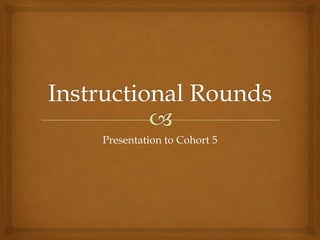
Instructional Rounds
- 2. Analytic Introduction 12:20-13:00 & 24:23-25:16
- 3. What are Instructional Rounds? According to: (City, Elmore, Fiarman, & Teitel, 2009) Instructional Rounds are a disciplined way for educators to work together to improve instruction This practice combines three common elements of improvement: classroom instruction, improvement strategy, and a network of educators. Medical rounds is the most important way physicians and teaching hospitals teach and share knowledge
- 4. Instructional Rounds vs. Supervision /Evaluation Instructional Rounds Supervision /Evaluation Rounds are an inquiry Only the person being process. People doing observed is expected to rounds should expect to learn learn themselves Supervision is about Rounds are descriptive fixing individual and analytic, not teachers evaluative Focused on the students Focused on the teacher
- 5. Instructional Rounds vs. Supervision /Evaluation Supervision and Instructional Rounds Evaluation Learning Inquiry: Group of learners Main learner: The Stance observed Unit of Meant to improve the collective (e.g. Meant to improve the Improvement school system) individual Accountability Lateral (peer-to-peer) Top Down Primary Focus The Instructional Core, especially the The teacher students and the tasks they’re engaged in City (2011, p. 39)
- 6. The Instructional Core Teacher task Students Content
- 7. A Theory of Action The essential principle of a TOA is that it provides a direct link to the instructional core—the vital activities that need to improve teaching and learning. (City, Elmore, Fiarman, & Teitel, 2009, p. 45) Causal: If/then… A well-developed TOA can find a clear path through the clutter They don’t have to be perfect…you can always revise. Developed by key constituents
- 8. Examples of TOA If I/we use data in systemic ways as a vehicle for examining school, classroom, and individual student progress, then interventions will be targeted in focused ways and achievement will increase. If we continually develop the instructional expertise of our teachers, then teaching will be strengthened and all students will learn in deeper and more meaningful ways. If we develop the efficacy of students so that they become active participants in their learning, then students will fully engage in school and develop the habits of mind that lead to successful lifelong learning.
- 9. Examples of TOA If ongoing assessment is used to drive instruction in the classroom, then student individual learning needs will be met If we provide teachers professional development in scaffolding higher order thinking (HOT) questions, then students and teachers will increase HOT question use, thereby improving inquiry in the classroom
- 10. Steps for Instructional Rounds 1. Assemble a network: Peers, cross groups, etc 2. Define of Problem of Practice: “A problem of practice focuses on instruction, is observable and actionable, connects to a broader strategy of improvement, and is high leverage ( City, et al., 2009) 3. Observe in classrooms: descriptive, not judgmental (chapter handout). Then analyze…e.g. students ask low level questions 4. Identify the next level of work.
- 11. Why do Instructional Rounds? To build a common understanding and language To reduce variability To focus our work To put educators in charge if their own learning To guide professional development
- 12. Activity Create your own Theory of Action… 1. Groups of three 2. If/then statement… 3. Something we can see/hear in the classroom 4. We will share our group TOAs. 5. Follow-up…
- 13. Follow-up One group to share their Theory of Action Connections Protocol Speak if you want to Don’t speak if you don’t want to Speak only once Listen and note what others say, but do not directly respond. This is not a discussion Avoid judgmental statements
- 14. Thank you Good luck!
Editor's Notes
- The instructional core is the relationship between the teachers, students and content, not the qualities of any one of them by themselves, that make up the core. This is the actual work that students are doing, not what the teachers is necessarily asking them to do. If you change one area, you affect the other two areas.